#a world without vertebrates
Text
A world without vertebrates: Myrmecos, the planet of the ants!
So, I've been looking for a solution to the question: Why did vertebrates fail to flourish on Myrmecos?
I think I have the answer: No Armored Fishes. If there were no armored fish then the Eurypterids would have continued to be apex predators longer. Some might have filled the hunting niche of early tetrapods. Arthropods were already on land, but you get a second wave.
The land gets built up with arthropods and fish are trapped in the seas!
And in this universe earth is the exception. Not only is earth far away from all of the other living planets it's one of the few with land vertebrates. The armored fish driving tetrapods on to land was a kind of ripple in the intended pattern. It threw everything off!
And just looking at The Dunk-- it is kind of unnatural, don't you think?
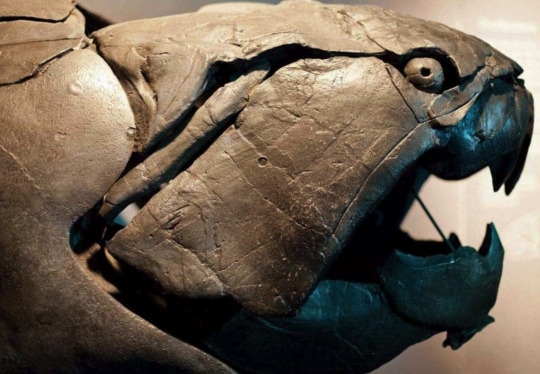
This also means that the ants will keep describing humans as "intelligent life from the sea" -- even as we keep explaining that everything came from the sea and it was a long time ago...
To them having a backbone means you are adapted to living in the water.
(I'm adding "Evolution of Ant" to my list of things to draw.)
It would be like one of those old-school natural history museum murals. Starting with single-celled life in the tidal pools of early Myrmecos, then the first multicellular life, then the first sea arthropods, then a momentous moment when a little crab creature first steps on land! Then the early insects, primitive solitary wasps with the glimmers of consciousness, eusocial insects discovering fire ... and at last ants!
-----
Hmm it occurs to me reading about the history of human aviation and all of those people longing "to fly" might make ants very uncomfortable.
The ants have never had much fascination with flight. (Space is another matter.) Any queen or drone can fly. It's considered a sign of maturity to pull one's wings off and get on with life.
Flying has primitive, and also vaguely sexual connotations so all the documentaries about people like the Wright Brothers just make Humans sound hopelessly horny.
#ants#speculative biology#speculative evolution#planet myrmecos#the rise of the ants#humans are fish#a world without vertebrates
33 notes
·
View notes
Note
I'm curious how dragon taxonomy works in Prince of Gold, since Centaurs are included in that clade.
'Dragon' is the term to describe all creatures descended from ancient hexapod vertebrates in the setting which are descended from a common ancestor.
Colloquially, common centaurs tend to use 'dragon' in a general speech to refer to scaly dragons, ie. any hexapod that is mostly covered in scales. Even tho fire dragons like cattle (a small domesticated sauropod-like dragon commonly bred for meat and milk) and Fire Drakes are more closely related to salamanders (a scaleless wingless semi-aquatic hexapod kept for wool, highly flammable saliva, and milk) than they are to the poison dragons like wyverns and basilisk who are more closely related to gryphons.
Centaurs belong to the Order of dragons that adapted to flight using their middle set of limbs as wings. Centaurs secondarily lost their ability to fly in exchange for being really damn good at running, but traces of their ancestor's wings can be found in the long spurs on their front legs and the skin membrane that extends from the elbows of their front legs to their hips and/or knees of their hind legs. The other species in the same Family are sphinxes, who remain fully flighted semi-social ambush predators, and manticores, a semi-flighted solitary ambush predators. A different Family in the same order were middle-wing flighted herbivores like pegasi and winged wild boars.
Wyverns and Gryphons belong to an Order of dragons adapted to flight using their first set of limbs as wings. The Griff (colloquial term for gryphons and their close kin) Family is fully feathered and lack poison/venom and the majority of them are large apex predators. Gryphons have cat-like hindquarters and live in the mountains. Hippogriffs evolved alongside centaurs as their major predator in the open plains chasing them down with their own long horse-like legs. The wyvern Family are sparsely feathered, with some feathers adapted into poison-filled quills, and use venomous fangs (or venom spitting in the case of basilisk) to defend themselves from larger predators like their griff cousins.
The fire dragons (most of which actually are all in the same Family, a bunch of long-necked herbivores that evolved to weaponize their methane production) are in the same Order as salamanders and tarasque.
Wyrms belong to two different Orders that reduced their number of limbs as they became burrowing and/or swimming creatures. The only fire dragon that isn't from the same family as cattle and fire drakes is the lindworm, which uses a chemical reaction similar to that of a bombardier beetle to produce its stone-melting flames.
Basically, 'dragon' in this world is used the same way that we use 'reptile'. A bunch of shit thrown under a term with only some of them having close common ancestry due to outward appearance which shit that does share a common ancestry but not looks left out when non-scientists are talking like how people leave birds out of reptiles when all their closest relative are all considered reptiles.
#nix responds#prince of gold#centaurs#dragons#fun fact! no dragon species in the setting can use fire magic not even the dragons that literally spit fire#also the tetrapod vertebrates are most likely nativized aliens and not actually things that evolved naturally on Aran#which would explain how regular horses exist in this world given the everything working against horses existing in this world#like directly competing with pegasi for the exact same niche but without the ability to fly away from large flying predators
4 notes
·
View notes
Text
Fish of the Day
The fish of the day today is the devils hole pupfish!
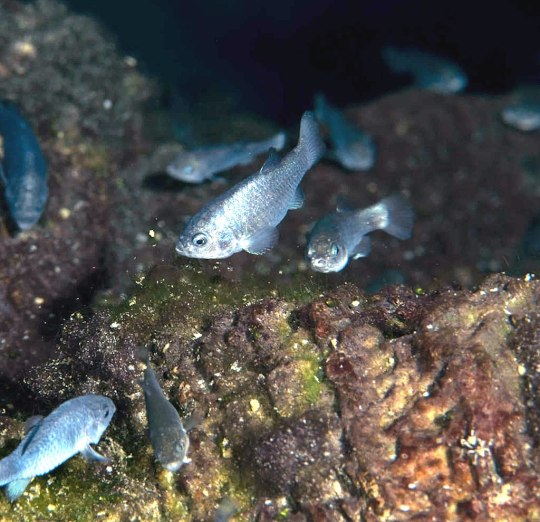
The devils hole pupfish, scientific name Cyprinodon diabolis, is an endangered fish known to live in exactly one spot, Devils hole. Devils hole is a limestone cavern with a geothermal pool found in Nye county of Nevada, and a disconnected section of Death Valley National Park. The geothermal pool keeps the water at a consistent 33 degrees Celsius all seasons, and has low dissolved oxygen amounts. The surface of water at the cave is only 72ft by 12ft, but below that the cave descends deep into the earth. Below the surface pool there is a larger cavern descending to 150 meters at its deepest before branching into a smaller tube at the bottom, the depth of which is currently unknown.1965 two teenagers went diving in the hole with scuba gear, and were never seen again, rescue divers sent after them found a dropped flashlight, and other scuba gear but the bodies were never found. One rescue diver dropped a weighted plate that fell a full 932ft without contacting a bottom to the chamber, describing the water below him as an "infinity chamber". Later scans of the cave revealed it is at least as deep as 1,247ft, although to this day the depth is still unknown. Another well known aspect of the cave is that it can be used to determine when there are earthquakes all over the world. The water surges and has displayed unique patterns during the 2022 Mexico 7.6 magnitude earthquake, along with other strong earthquakes further from the hole. Such as: the 2012 6.2 magnitude earthquake in Papua New Guinea, or the 2018 7.4 magnitude earthquake in Indonesia. Devils hole pupfish are known to live only in the first 80ft of the cave.

Devils hole pupfish are unique in appearance, getting only as large as an inch, and being one of few species that have no pelvic fins, however when raised in colder conditions these pupfish will regrow these appendages. As juveniles these fish are an off white color, and females retain some of this coloring in adulthood. This species has only ever been recorded with as many as 500 wild fish at its highest, hitting an all time low point of 42 fish in 2007. The more recent numbers are looking up however, and there were 263 pupfish observed in spring of 2022. The survival from egg to adulthood is small, but the likelihood with human effort that this fish will survive the test of time is high. Described as possibly the most isolated wild vertebrate species in the world. These fish live only 10-14 months, reaching sexual maturity at 8-10 weeks old and spawn year round with peaks in mid February-May, and a smaller peak in July-September. Due to the unique oxygen levels of devils hole, these fish have adapted to enter a state of tupor, similar to hibernation, where they can live anaerobically. This allows them to go without breathing for up to 2 hours, however they produce ethanol as a byproduct.
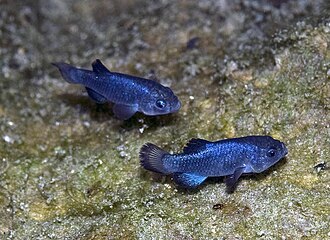
Most of the devils hole pupfish life is on the rocky outcrops of the surface waters of the cave system. Breeding, egg laying, diet, resting, and schedules surrounding the placement of the sun all depend on these rocky outcroppings of stone near the surface of the water. The diet of these fish is dependent on the rock outcroppings of the cave, as they eat anything they can find in the cave system. This includes: small freshwater crustaceans, beetles, flatworms, freshwater snails, inorganic matter made of small sections of the caves limestone, along with spirogyra and diatom algae, which grows on the rocks themselves and makes up most of the pupfish's diet. Due to their diet being mostly algae types, pupfish are incredibly susceptible to the seismic activity in the devils' hole, as it creates small tsunamis along surface water and washes away algae on the rocks, leaving them without a majority of their food source until it regrows. When these earthquakes happen the pupfish are known to flee into the deer waters of the cave until the water has stilled, and are thought to perhaps feel earthquakes before they happen, although not much research has been done on this yet.
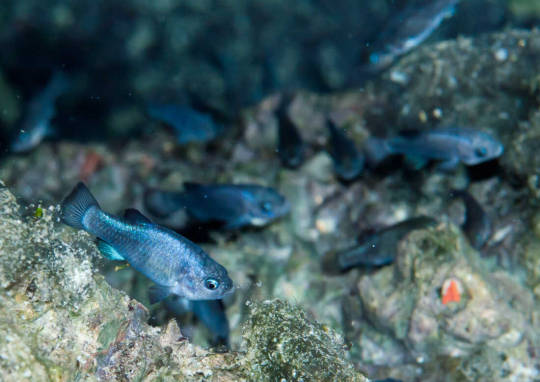
Have a good Wednesday, everyone!
#pupfish#fish#fishblr#devils hole#devils hole pupfish#nevada#Cyprinodon diabolis#death valley#death valley national park#ash medows#ash medows fish conservation
169 notes
·
View notes
Text
Some features of the earth urchins compared to the four hedgehogs of the world of Sonic!

One day I asked myself the question of how would be the anatomy of Sonic and I began to investigate the anatomy of the ground urchins but I liked so many details of them that I put together some characteristics of these animals to compare them with the four hedgehogs of the world of Sonic.
us start!

Starting with obvious facts:
In the world of Sonic only showed to have four hedgehogs; Sonic, Amy, Shadow and Silver, (the green does not count because it is still Sonic)

They all appear to be of a "same species of hedgehog".
For we know 16 types of earth urchins on our planet.
On the other hand I thought Silver was of a different species like Shadow. (By the shape of its spikes) But I don’t see the point, so they must be the same species. Although Shadow might be a little authentic in his design, I’ll explain later.

(Data: the hedgehog Atelerix algirus and the hedgehog Hemiechinus auritus are the ones who take care more to be pets at home)
FOOD
-Ground urchins eat insects, worms, molluscs, snakes, some fruits, small vertebrates, acorns, young birds and eggs.
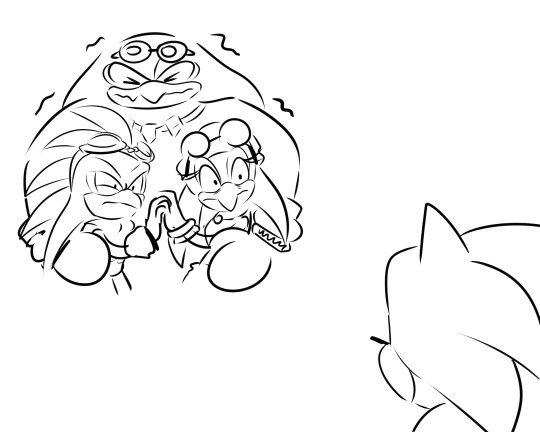
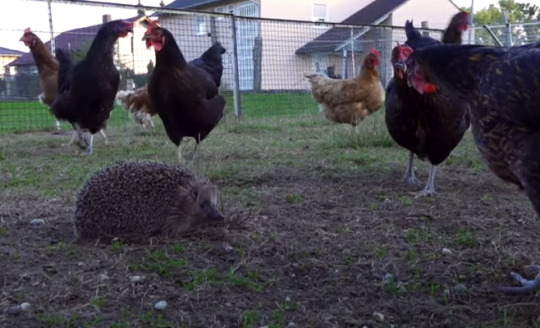
(the hedgehog thought about it a little before attacking)
-Sonic and the others eat things that could be considered human; chili dogs, coffee beans (this is done by Shadow), strawberry cake (eaten by Amy and Sonic hates it), hamburgers (by SonicBoom), apples (by a drawing of Silver), and so on.
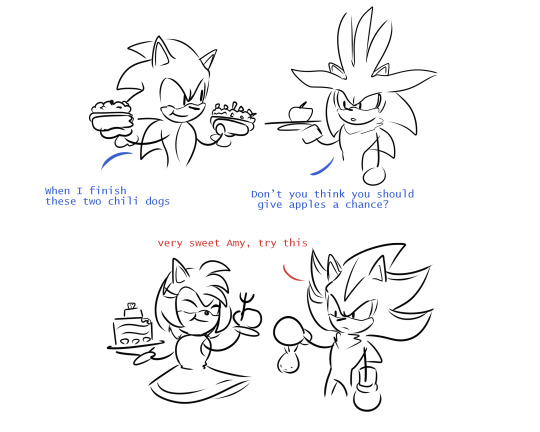
ANATOMY
The ground urchins have very good flexibility, an arched spine and strong and flexible muscles, that allows them to become ball. Comparing it with the deformed hedgehogs (Sonic) there is not much difference since all present good strength and flexibility, except Silver that can not be made ball.
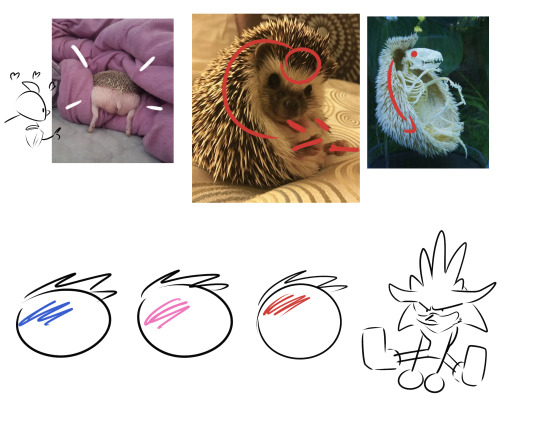

The spikes of hedgehogs are made of keratin, which is a protein substance. I guess the same applies to Sonic and so on.
Although in Sonic Unleashed when he is electrocuted we can see that it does not have "bones" in its large spikes, it is a little obvious to know but data that goes without saying.


The skeleton of ground urchins is similar to other mammals, only that its spine is a little more curved, as well as other details; as that its clavicle is well developed so that it can dig hard. This is very different from Sonic’s body and so on as it would resemble more a human structure.


Although also to keep in mind Sonic’s feet are… a closed thing…

By the way the snout and mouth are very different too. Sonic has a snout but the nose and mouth are different from the ground urchin.
And another fact: the hedgehogs take incredibly long walks if it is for food; something like 7.2 km/h and if we combine it with the particularity of Sonic being very fast this powerful detail does not overlook.
Time when I jumped out of my spot when I was reading this.
I love this, I have no idea if the creator of Shadow has taken this as a reference but did you know that hedgehogs have a blue border that surrounds their dark eyes? This can only be seen when hedgehogs look to the side. So the great "eyeliner" of Shadow could be a real detail of the animal but taken as a reference to leave it beside your eyes on the outside.

The tail of the common hedgehogs is bare, but the tail of the deformed ones appears to be of the same color as all their other spikes.
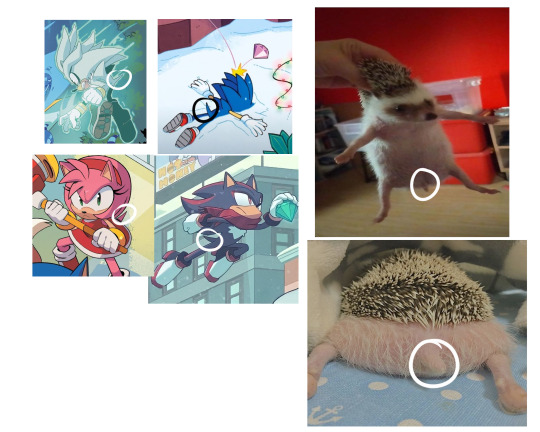
I think, canonically, the characters of the Sonic world can mate. But I didn’t see anything that highlighted this, I mean, we can witness Cream’s mother.
Male hedgehogs have a small penis, (bulge), located in what would be their navel and have intra-abdominal testicles (they remain in the abdomen instead of leaving through the scrotum) and the female vulva is a small button that is located in front of the anus.
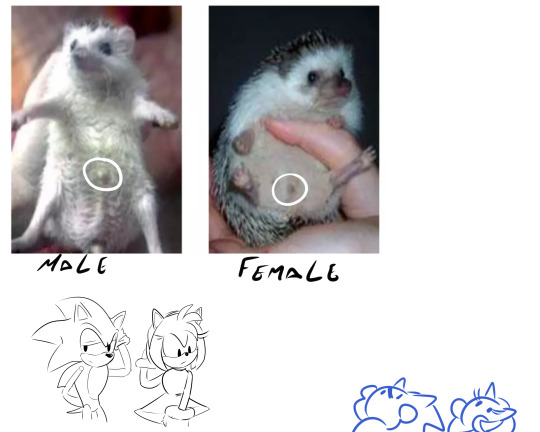
I guess since they’re characters from the '90s, it’s obvious that this wasn’t thought of at the time of their creation.
There’s not much to think about since they’re characters who may or may not wear clothes (Tails-Nine and Sally-Amy) and yet we wouldn’t see anything, not even the nipples! Because hedgehogs have five nipples, both female and male, and you’ll notice that Sonic has nothing.
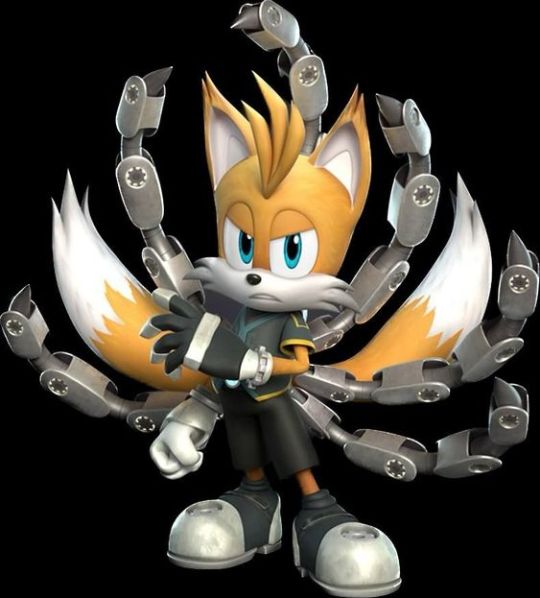

But I found a picture of Sally where she has more clothes. I suppose it must be a hallmark that female characters wear clothes. (Although Sally is not a canonical character, of course.)
THE 5 SENSES:
Sight: they do not have good view, it is said that hedgehogs have no sense of space, but they can distinguish shapes.
Although the hedgehogs are blind and may have collisions with objects, they continue to travel great distances and this does not cause them to slow down, they continue with the same speed as if they had good eyesight.
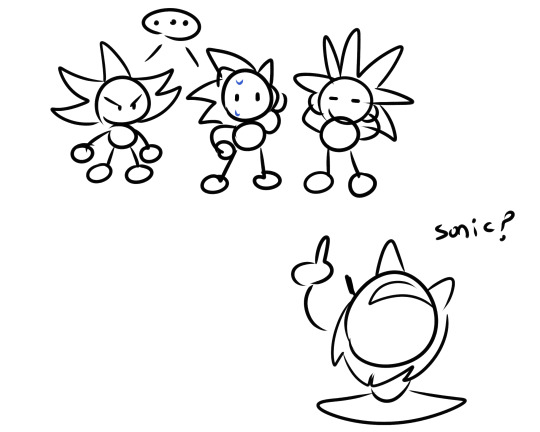
Smell: very developed, so I guess the four hedgehogs can smell very well from several meters, maybe Sonic can smell Eggman without making noise, will smell of egg?

If you hid a chili dog under the ground in a box, Sonic could find it.
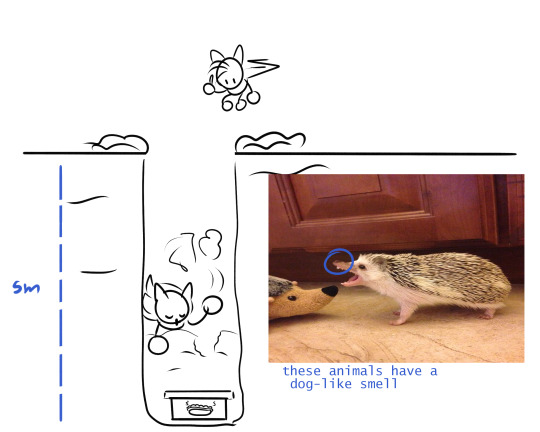
Hearing: the ear of hedgehogs can detect high frequency sounds, their developed sense allows them to locate their prey underground.

Tip: If you saw the Sonic Prime series you will notice that Sonic’s ears move often before a sound. I think a good detail added for the blue hedgehog, this is also added in the IDW comics, I did not find the panel but it is when Amy stays listening to the ground and knows that two hedgehogs are close, those hedgehogs were Shadow and Sonic.
But although hedgehogs have a very sensitive ear I do not consider it the same for the four hedgehogs as they would go crazy at the sounds of Eggman machines, explosions or a simple click of the computer mouse. (Ground urchins get stressed too fast with a simple computer click)
Taste: These animals have a peculiar… sense of taste. They like the taste of a hundred feet.
So it’s not uncommon for Shadow to like bitter, for Sonic to like spicy, and for Amy to like sweet, what would Silver like? Healthy or the first thing he finds in his world to eat?
Types of sounds hedgehogs make
Sounds of joy: these little things purr like a cat, and they can even mix it with whistles. Could it be that Shadow purred when he was with Maria?
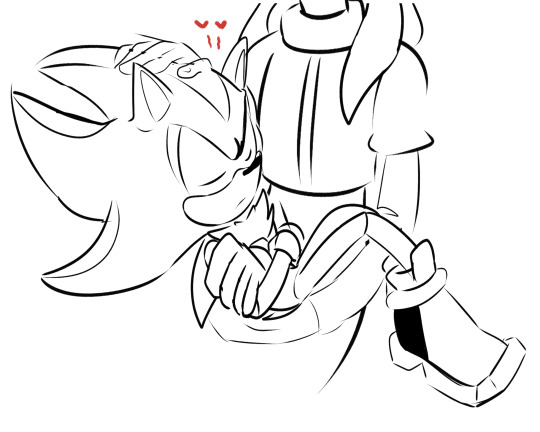
Bullying sounds: they emit a sound through the nose from a strong breathing, they do it when they feel attacked or are upset. (I don’t know if they thought of it this way when they made Shadow growl annoyingly in Sonic Prime. The same with Amy and Sonic when they got jealous or bothered with each other at Sonic Boom)
Whining sound: when they feel pain they emit a sound like a scream, I could notice this in a video of a hedgehog that was in the water of a bathtub. (although there are always exceptions)
Sleeping sounds: Hedgehogs snore, I guess they all snore too?Hedgehogs fall asleep anywhere. In the Sonic game where Amy’s birthday is celebrated, Tails mentions that Sonic can sleep anywhere, even in the most unusual.
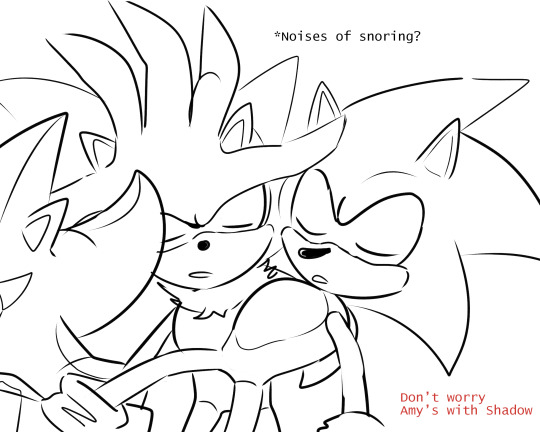
Data: the hedgehogs have nails/claws that they use to dig the earth and since the of Sonic characters are put gloves to not show their hands I think they should not have pads like normal animals but rather human hands. Well, Sticks is the only one I’ve seen without gloves and she’s a badger and badgers have pads. So all Sonic characters should have hands without the characteristics of their species.
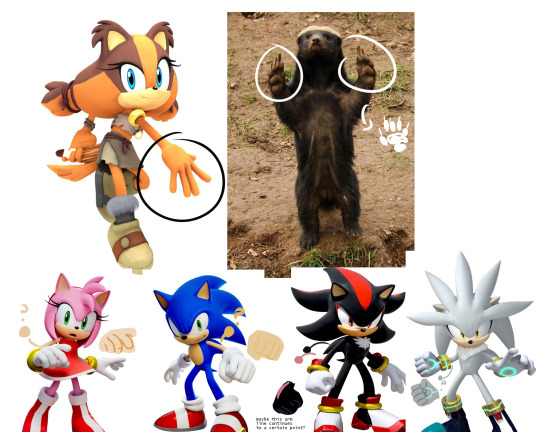
BEHAVIOR
The behavior of one ground urchin and the other four is very different, except Shadow, he should stay on the side of the ground urchins.

Since hedgehogs are solitary, they only come together when it’s mating season. (Although Sonic likes to spend time alone…but he’s not a lone wolf like Shadow)
UNGIMIENTO (I couldn’t find the word in English)
When tasting a taste or perceive a new smell, or rare, the animal bites the source of this flavor or smell (Animals, objects, people, whatever) to then make a frothy, thick and white drool that with the tongue are smeared on the side peaks and those near his face.
(Scientists don’t know why they do this)
If I imagine it for the four deformed hedgehogs maybe this does not exist for them, as they smell new things all the time.
youtube
EXTRA DATA:
Hedgehogs can swim but they don’t like to stay in the water too long because they can drown, I saw a documentary that mentioned this.
I like that touch they gave Sonic that in the water he is scary, I don’t know if it’s something canonical or fandom but it was nice to see him be the only one with a life jacket in the Olympics.

Remember when they did that twitter and tiktok special where they asked Sonic what would happen if he was a worm?
Well, hedgehogs eat worms.
And did you know that the Egyptian hedgehog is prey to foxes?
While it’s another kind of hedgehog this is funny.
In Sonic the movie the character Longclaw is the "mother" of Sonic… the funny thing about this is that she is an owl and owls eat hedgehogs.

Who had the idea to give a friend and mother predators to Sonic?
That’s all. I hope you liked these characteristics that I came up with.
See you later!
#sonic fandom#sonic the hedgehog#shadow the hedgehog#sonic fanart#amy rose#silver the hedgehog#Youtube
263 notes
·
View notes
Note
my mom recently read in a novel that some larger praying mantis species have been known to kill and eat hummingbirds. I know about bird-eating tarantulas, but I was curious if you knew of other insects who prey on birds, mammals, etc.? I know most will scavenge anything, but what abt critters who hunt? the idea of insects who hunt large prey is fascinating to me
large generalist predatory insects like mantises and katydids predominantly eat other insects, but the majority of the vertebrate prey they take is probably frogs and lizards, and typically ones smaller than themselves. hummingbirds might not be too representative of typical vertebrate prey because (I believe I heard a mantis researcher say) their metabolism is so tightly wound that the stress of being caught is enough to kill them, and all the mantis has to do is hang on, which they definitely can do. still, vertebrate predation is pretty impressive for orthopterans and mantodeans, since they’ve got to do it all without venom!
army ants of various types are also famous for their ability to catch vertebrates, but most army ants are actually specialists on other social insects (ants, wasps, termites), and the few generalist predator army ants still predominantly prey on invertebrates (and don’t skeletonize cows and horses like they do in cartoons).
diving beetles will hunt fish and aquatic amphibians—there’s a reason their larvae are called “water tigers!” belostomatid water bugs are probably the most impressive aquatic vertebrate-eaters though, and use powerful venom to subdue surprisingly large fish, tadpoles, and even other vertebrates:
outside of insects, there’s a lot of spiders that can feed on herptiles, either by overpowering them with strength like huntsmen and tarantulas, or by snaring them in webs like widows, the most successful snake eaters:
plus, there’s always the famous Nephila orbweavers whose sturdy webs can catch avian prey, but this is probably a fairly rare occurrence.
going over to centipedes, giant scolopendrids are quite successful predators of vertebrates, with any species large enough likely preying on herptiles, and occasionally on some far larger than they are!
Scolopendra venom is evolved to take down large prey, so it’s no surprise they’re some of the most prolific vertebrate-eaters in the arthropod world. some very large Scolopendra (gigantea, maybe galapagoensis, viridicornis, heros) will hunt bats, sometimes by hanging to catch them in flight. other predation on mammals and birds seems to occur opportunistically, especially where the prey is helpless: S. galapagoensis was recorded feeding on baby rodents in the Galapagos; other island species like Cormocephalus coynei will feed on seabird chicks (enough with the “fluffy” avian favoritism, Nature! ‘pedes gotta eat).
oh, speaking of nestling-devouring, there’s also some freaky observations of slugs munching on soft mushy songbird babies! someone on Twitter had their nest camera record some chicks getting eaten by a large Carabus ground beetle, but I can’t find it again.
but I think the most shocking example of vertebrate predation by an invertebrate is probably Epomis, another ground beetle. as larvae, they feed on frogs far larger than they are by letting themselves get attacked, latching onto the would-be predator, and munching on it until it perishes. adult beetles also prey on amphibians, but just run them down instead of luring prey.
youtube
(there’s also video of the adult beetles preying on frogs, but they seem to all be stolen by some weird content scraper YT channels, so I’ll not post them here.)
let me know if I missed any good examples of vertebrate predation by bugs!
309 notes
·
View notes
Text
Spectember D12: Alternative history
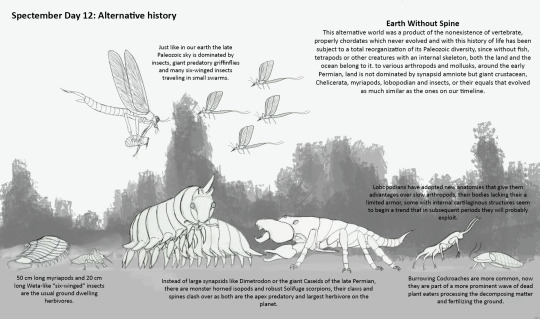
The early Permian of this alternative timeline physically looks almost the same, same geography, same flora, same events of mass extinction, but there is a considerable difference that is remarkable when one checks on the fauna, there are arthropods wandering around, of different sizes, of different shapes, alongside them there are other strange velvet worm like forms, some large mollusks, but what we could recognize nowhere to be found; in the rivers, there are more arthropods and mollusks, and even some large worms, but not bony fishes, sharks or anything that resemble a vertebrate, this world have never seen vertebrates ever.
Something happened through the beginning of the Paleozoic that caused to vertebrates to never evolve, leaving a gap in history that only other animals would fill on their ways.
Moving towards the Silurian and Devonian started to show the consequences of this change as without any type of fish, shark, placoderm, anything that we could relate to the the early paleozoic vertebrate diversification did not happen and the result of such vacuum was the diversity of arthropods and mollusks, some larger species of marine arthropods/panarthropods evolved, some larger mollusks did evolve too, cephalopods and gastropods became predominant where large marine vertebrates should dominate, and in the coasts the trend of arthropod conquest was ongoing as on our world, evolving convergently things like insects, myriapods and arachnids, alongside many other terrestrial crustacean species.
The carboniferous had a different face on land now that since there were not tetrapods taking over and with arthropods like insects and arachnids evolving similarly to our world species, they were fully conquering the planet with diverse and large sized forms, from the early carboniferous to the cooler late period, insects were dominant in numbers on land and the sky, myriapods were the usual predominant herbivores, and arachnids took over predatory roles, being scorpions the apex predators, secondarily were with them some isopod like forms, more packed and suited for dry land so they could extend off the humid forest regions, as well velvet worms which started to be more prominent in some minor parts of the ecosystem.
Up to the early Permian with the desertification of the landscape and loss of environment have pushed the most adaptable species on changing to face the new life conditions, many of the gigantic forms remained, new ecological trends started to appear within some groups, and so this spineless version of the Permian is full of a new cast of arthropods.
The north america of the Early Permian is a land dominated by 50 cm long Solifuge-like scorpions that have evolved with robust chelicerae, more used to large prey they are the apex predators on land, meanwhile in the sky 40 cm of wingspan robust griffin fly predators have evolved, more heavier lethal than any other odonatan, herbivorous palaeodictyopterans still swarm around as well; on the ground is different types of omnivorous and herbivores arthropods going along, there are Arthropleura-like myriapods, but along them some other arthropod herbivores have developed more chubby and taller, these isopod-like armored forms are as big as 1 m, they are close or even heavier than any of the flat Myriapoda; smaller herbivores surround them along, such as 20 cm long flightless cockroaches and Weta-like Palaeodictyopterans are common small herbivores; lobopodians grew up to 30 cm in length, gracile and are among the most agile terrestrial animals on land, sort of evolving a complex inner cartilage skeleton, might become the blueprint of a new future group that will take over in the next periods.
#speculative evolution#alternative evolution#arthropod#paleozoic#permian#insects#myriapods#velvet worm#lobopodia#arachnids
101 notes
·
View notes
Text
Imagine you had to send yourself to another dimension. You can't stay on your own anymore, and you know you're probably never going back.
You wake up in a giant forest, with trees the size of mountains or skyscrapers. Dragonflies the size of falcons fly overhead. And you can see grasshopper like beasts the size of deer running through the woods, pursued by wolf sized arachnids. Cenepeds slithering across you like snakes.
Eventually the sentient population finds you. They're human shaped, very skinny for the most part, and covered in glistening white exoskeletons instead of skin. They're faces lack any Immediately visible features other then two giant orange eyes, though their mouths become visible when they open them. They have hair on their heads in human like patterns, but it's silky like that of a moth. They seem to have two sets of arms, though only the upper set is able to be fully utilized for tasks.
They're confused at you at first. The only vertebrates they've ever seen resemble tiny lizards or rats. But when you try to communicate they take you to their largest city, or at least the largest in the area.
You're taken to a large stone sitadel, and begin doing tests on you, though they take care not to hurt you. After a few days you're set free in the city. You know enough of their language to get by. And one of their universities will give you a small apartment and some money every month in exchange for regular samples of blood and urine.
Their society seems mostly humane. Democratic, with a late 20th century level of technology. But for awhile it just seems to alien to you to assimilate at all. You can't make freinds at first, you can't pick up on their body language due to how diffrent they are.
Eventually you start socializing more. The idea that you'll ever see a human again seems more and more a fantasy. So you do what you have to. First with people from the university, then with just people in the community. Should you even call them people? It's like everything, hard at first, then it seems normal.
You get used to their food in time. Eating meat and drinking bodily fluids from giant insects. It's the thing you have to get used to the fastest, as you'll starve without giving up your discomfort.
The creatures here don't really wear clothing. Sometimes jewelry or capes but nothing that covers their bodies like human clothing does. You try to wear the clothes you came in, but those were out. And when they're gone there's nowhere to find replacements in this world. You don't know how you feel about being naked, but since it doesn't bother anyone else it eventually seems normal.
You live a good life for a time. You have freinds. A respectable job as a dimensional researcher. You marry someone from this realm, though it took awhile for your mind to rewire itself to be attracted to these creatures. Eventually you forget what it even felt like to be on earth, to see another human.
One day, when it's been over a decade since you left, a rescue crew from your home dimension comes, saying the danger is gone, that you can come home. But this is your home now. And other humans just look like animals now, like lizards or rats that might scurry around your home.
#196#my thougts#worldbuilding#fantasy#writing#my worldbuilding#my writing#creatures#fantasy creatures#creative writing#short fiction#short story#flash fiction#science fantasy#science fiction#sci fi#scifi#lovecraftian horror#aliens#spec evo#speculative zoology#alien species#speculative fiction#speculative biology#dimensions
114 notes
·
View notes
Text
My Top 5 GARBAGE fish that suck
Here we go again. After receiving a very high ammount of notes!! (61 UwU) on the last fish list, here's another top 5 no one asked for.
I've tried to use the reasoning of ''all fish are good'' but let's be honest, we'd be better off without these.
5. Monkfish🙏

So these things are weird as hell. Their ugliness alone landed them on this list. Not only are they ugly as shit, but they're also mean motherfuckers that eat basically anything. They like to cover themselves in mud and just chill there until something crosses their path which imo is fucking lazy. Some people do eat them as a delicacy apparently(ew?). Props to them for getting over the looks.
Ugly/10
5/10 for laziness
4.Hairy Frog Fish💇♀️

If you wonder wtf are you looking at, this fish is the living embodiment of that feeling you get when you find hair in your food.
This girlie loves to swallow as it's mouth can open to make space for fish almost twice her size so don't go sitting too close 💦 Still, it doesn't take away from the fact that she looks like a mistake.
4/10 appearance
8/10 for the deep throating skills
3. Goblin Shark 👺
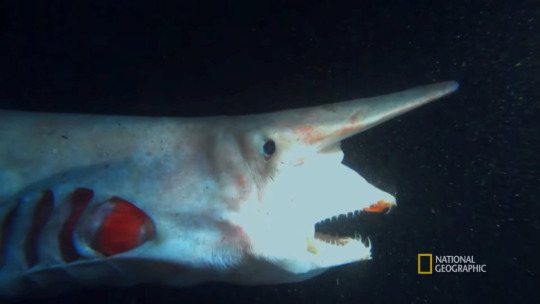
First of all, these sharks look like if someone designed a fish based on a child's drawing of a shark. Instead of going the terrifying route and choosing one of these pictures, I opted for a derpy yet still creepy photo.
Besides being quite good at ambushing prey, these dudes still tend to eat man made garbage which further argues their position on ''the garbage fish top5™''. They also are basically living fossils since they're old af and most of their body is atrophied.
3/10 appearance
6/10 for still living so long despite everything.
2.Bony-Eared Assfish🍑

This fish is for all ass obsessed fuckers. Grilling this baby and enjoying it counts as eating ass. Some cool facts about him:
-The bony-eared assfish has the smallest brain-to-body weight ratio out of all vertebrates.
-Assfish are soft and flabby with a light skeleton (so like a real ass)
As for personality, they are not what I'd call assholes. They are quite sluggish as they prefer to sort of flap around with short bursts of energy instead of swim. They don't do much besides that which makes them a very underwhelming fish despite the sexy name :( Apparently they were given this name to make up for how utterly boring they are.
2/10 appearance
1/10 Interest in them or what they are good for (spoiler, nothing)
If you're a fish enthusiast, you probably know what's coming at nr.1
🥁
🥁
1. Ocean Sunfish☀️

There are far, faar too many reasons for this fish to be on the first spot. Not only are they the dumbest fish in the whole world, but they also are not good swimmers AT ALL (wtf is with these poorly designed fish who cannot swim??). Scientists are still perplexed at how this fish continues to stay alive. If you want more shitty facts about them, here's a link to a very famous post trashing these bitches.
BUT, I have my very own reason to hate the sunfish.
One cursed morning, I decided to go get educated about animals and visit Naturalis, a museum in Leiden, The Netherlands.
I was having a blast looking at all the beautiful animals showcased, along with the cool facts and atmosphere.
I excitedly get to the aquatic creatures floor and mesmerised, I try to take in all the beauty. At the long corridor nearing the exit, I look around admiring the fish that were displayed. Thinking I had seen it all, I move further when I turn a corner and out of nowhere..
.
.
.
.
.
.
.
BAM
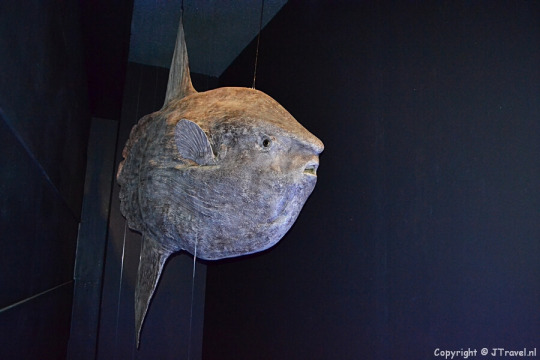
this GIANT motherfucker, hidden in a corner makes it's presence known. I'm not kidding when I say this thing is huge. Here's a picture of the replica from another angle for size reference.
As you can guess, I was legit extremely spooked and actually screamed. :(
0/10 appearence
0/10 fuck this thing. useless and it gave me a heart attack
BONUS:
I'm sorry but I think I've tortured myself and you enough, so to make up for it, here's a cute fishy instead:
(take him)

Alright thanks for reading and follow for more fish content.
Suggest me some more top5's I could do, be it fish related, or whatever your mind decides to curse me with.
Still need to cleanse yours eyes?
My top 5 coolest fish
#my most hated fish#fish#fish that are NOT friends#marine life#things that make me unhappy#top5#ocean#aquatic life#fishblr#fish tag#animals#animal enemies
299 notes
·
View notes
Text
More Wyrm Things
just some more wyrm(and PK) headcanons.
Wyrm:
They don’t really sleep in the same way that other bugs, beasts, and higher beings do? Like it’s something a bit like how dolphins sleep with half their brain, but on a much more diffuse scale. The result is that they don’t sleep but do have more and less active periods.(this is also why PK was immune to the Radiances influence and why he felt comfortable moving his palace into the dream realm)
They’re fully capable of closing their inner throat to avoid taking in excess water if they burrow through a aquifer underground.
Aditionally Wyrms aren’t really bugs so they don’t actually have spiracles like bugs do, I’d make the wager that they’ve got lungs or some other stranger form of respiration.
It actually seems like Wyrms are vertebrates? Like the wyrm corpse has what look like vertebrae. I think the track of evolution on hollownest world probably has a group of creatures with both a skeleton and an exoskeleton. These would be some kind of fusion of reptiles and crustaceans, this is the group Wyrms and their distant kin belong to.
Wyrm meat is very tough, luminous, and highly toxic to most beings. Of course roots can devour a wyrm corpse without issue.
in lower form(ie after dying) most Wyrms choose to be taller than the bugs that worship them and also still mostly rely on touch and scent over sight.
Wyrms like very dry and windy conditions, in fact stagnant air and high humidity will actually cause respiratory issues and begin rusting their outer coat of armor, making it much harder to move and shed.
PK:
He doesn’t like having bugs that don’t share his pale color scheme in his palace for any length of time.
in fact this might be a wyrm thing in general but aesthetics matter a ton to him, like it’s sorta an OCD thing? But he needs things to be on theme, at least where he lives. Colors that complement it(like red) are tolerated.
when he first met the white lady he was terrified of her. She was the only other pale being he’d met, and he expected their meeting to end with one of them consuming the other.
in general he tries to distance himself from the culture Wyrms have, he only indulges his instincts in private.
he’s a messy eater, so when he holds court and does politics he generally doesn’t eat. I think most denizens of Hallownest think that gods just don’t eat because of this.
He has fantastic spacial awareness and impeccable memory. Yes this does mean he remembers every single mask in the abyss intimately.
He nibbles on things when anxious sometimes.
He wears such a long cloak to conceal the parts of his body where his understanding of lower bugs and beings failed and he made mistakes. He’s got some really fucking weird joints, and seethrough bits( especially over his heart, it’s why he wears his part of the kingsoul there.
his head might be mostly hollow tbh, it’s a lot like the maw of his wyrm form, in a sense it’s even appropriate to say he doesn’t have a true face.
Parts of his brain are actually stored in his lower body and chest, not that it really matters because as a god he’d survive even without a body. Though he’d have a harder time with that than the radiance. He’s a god of the physical world and she’s one of the ephemeral world.
he likes the taste of mint, to the horror of the bugs around him(it’s a toxic insect repellent to them)
he has little ingots of metal he eats, like candy bars but very dense. It’s because he needs metal in his diet, something which hornet deeply regrets inheriting from him.
#hollow knight#Wyrms#hk pale king#hk headcanons#speculative biology#hk hornet#Hk higher beings#Gods#what do you think?
45 notes
·
View notes
Photo

Helmeted Guineafowl (Numida meleagris)
Family: Guineafowl Family (Numididae)
IUCN Conservation Status: Least Concern
Widely distributed across Sub-Saharan Africa, Helmeted Guineafowl (singular and plural) are easily recognized thanks to their striking spotted bodies, featherless blue-skinned heads and namesake bony "helmets” (which are short and rounded in females and taller and sharper in males.) Spending the day foraging on the ground and roosting in the branches of trees at night, members of this species favour dry, open habitats and live in large flocks throughout most of the year, breaking up into mating pairs during the spring breeding season (with both parents working in shifts to incubate their eggs, which resemble speckled Chicken eggs and are laid on the ground in ditches lined with twigs and leaves, and to raise their chicks, which are known as keets and are born without the helmets of adults) and returning to larger groups after their chicks have fledged in the late summer. The diet of Helmeted Guineafowl varies seasonally; throughout most of the year they feed largely on grasses, seeds, bulbs and roots, but as their nutritional needs change during the breeding season small animals such as insects, arachnids, snails and small vertebrates become more prominent in their diet - in particular, they are known to feed on large numbers of grass-dwelling ticks during the spring, and in doing so benefit other animals within their range by limiting the ability of ticks to spread between hosts and transfer diseases. While foraging in groups Helmeted Guineafowl vocalize near-constantly to notify their flockmates of their presence, and at the first sign of one of their many predators (including Leopards, Servals and a wide range of large snakes and birds-of-prey) the first individual to spot it will produce an extremely loud alarm call, prompting the group to scatter and run for shelter (although members of this species can fly in short bursts, they are far more capable on the ground and will only take to the air as a last resort.) Both within their home range and throughout the wider world captive populations of Helmeted Guineafowl have been farmed for their meat and eggs for centuries, allowing escaped feral populations to have become established in parts of Australia, Europe and North America.
--------------------------------------------------------------------------
Image Source: https://www.inaturalist.org/taxa/1428-Numida-meleagris
#Helmeted Guineafowl#guineafowl#bird#birds#galliformes#landfowl#zoology#biology#ornithology#animal#animals#wildlife#african wildlife
55 notes
·
View notes
Text
Categorizing the Uncategorizable
(or, the divine is stored in the infinite mystery of life on earth)
I swear this is about lichen genomics but it’s not not about gender
Recently I was asked “What do you think of species described only from DNA?” That is to say, species not morphologically distinguishable from others but when tested genetically, show up with results different enough that some people have decided they count as a different entity.
Over and over again in my (short) career as a biologist I keep running across the question “What is a species, really?” It doesn’t seem like something that would be the subject of ongoing debate. We should be able to tell the difference between different types of creatures, right? Even if they look similar, if they can’t breed and produce fertile offspring, they are not considered to be the same species. This works for most vertebrates, as far as I know, but a brief glance at botany makes everything infinitely more complicated. Different species of plants are absolutely capable of interbreeding and producing fertile hybrids (that’s how we get so many fun cultivars to grow in our gardens). And by the time one considers lichens, the concept of “species” is more of a vague suggestion, or a shorthand we’ve all agreed to use while acknowledging its drawbacks.
Lichens are always already at least two species – a fungus and a photosynthetic partner (green algae or cyanobacteria) – combined into one “body” that looks unlike either partner would if grown separately. They are recognizable entities, a whole that is more than the sum of its parts, but the parts are always visible in cross section, or in the genomic data. And this is without even mentioning the myriad species of other fungi and bacteria simmering in the lichenological stew. The lichenological community decided to use the Latin name of the fungal component to refer to the whole lichen, since the fungus makes up the majority of the biomass and seemed to determine the morphology while the photosynthetic partner was more or less along for the ride. The same species of alga is also known to partner with different fungi to form different lichens, which was taken as evidence of its relative non-selectiveness versus the fungal partner’s specificity (something that has more recently been called into question). Regardless of one’s stance on the fungi-centric model, we can all agree that the idea that one genome=one species does not apply to lichens.
So why do we call lichens “species” anyway? Well, what else would we call them? They are distinct entities that live and reproduce and play particular roles in an ecosystem. They can be identified by their distinctive morphological features. And when so much work in biology relies upon knowing “what lives where”, we need to have a name for the “what”. So, we’ve given imperfect names to capture some aspect of our infinitely interconnected world. This is something we need to do, for the sake of communication.
But just like words can never quite capture elusive and complex feelings, grouping a set of organisms together and calling them a Latin binomial will never quite express the reality. We are only human, after all, and as much as we learn about the world around us, we are limited in the scope of what we can understand. I don’t think we will ever unravel every mystery in the natural world, and that’s not a bad thing. The more we learn, the more questions we have. What I’m getting at is that we can never have an omniscient view of every single biological interaction ever. We research and study and we get an approximation. It might be a very good approximation that answers our questions and contributes to our body of knowledge, but it is still an approximation impacted by the limits of our perception and our implicit biases.
The way I see it, using our human perspective to apply categories to the natural world is always a functional endeavor. We do not name lichens because we think this is what the lichen would call itself, or even what god would call the lichen. We name them because we are interested in them and we need something to call them when we talk to other humans. Endangered species lists are just that – lists of species. We wouldn’t be able to protect rare lichens without assigning them a species and putting them on the list. There will always be exceptions, and edges, and individuals that don’t quite fit. Evolution is always happening; we see populations that are not quite different enough to be their own species, but we can tell that one day, thousands or millions of years from now, maybe they will be. What do we name these? Perhaps a subspecies or a variety, perhaps not. The important thing is not that we’ve discovered the One Truth of the Universe, but that we are close enough to accomplish what we need to accomplish.
But are DNA sequences enough to define a species? I think not. We must consider again not what a species is, but why we describe species. We do not describe species for the sake of making up a name for a slightly different DNA sequence, we do it to categorize an entity we are interested in. If two lichens look the same, contain the same chemicals, and fill the same ecological niche, are they really different? And if they are, are they different enough to matter?
This is not an indictment of the act of naming species, or a call to stop trying to study and understand what appears unknown and unknowable. It is simply an encouragement to think more critically about categories and why we categorize. Why is it important to tell these two things apart? In what context would it become important? What would it look like to treat them the same? How much more can we learn from thinking consciously and openmindedly about what we mean when we say “this is a species”?
#lichen#lichens#lichenology#lichensplaining#science#biology#species concept#species#evolution#taxonomy#genomics#gender
235 notes
·
View notes
Text
Asteriornis vs Panraogallus
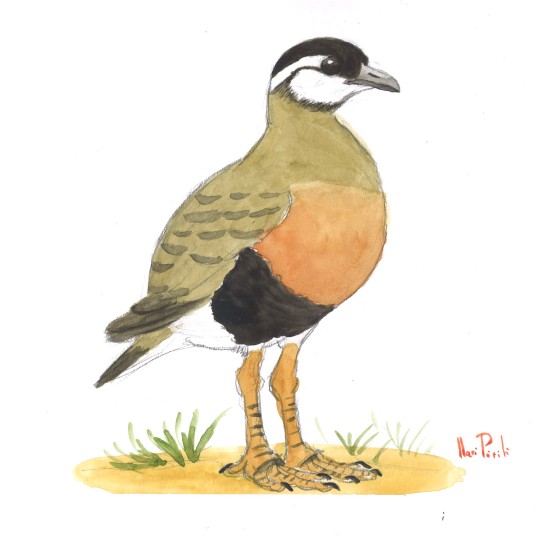

Factfiles:
Asteriornis maastrichtensis

Artwork by @otussketching, written by @zygodactylus
Name Meaning: Asteria’s Maastrichtian Bird
Time: 66.8 million years ago (Maastrichtian stage of the Late Cretaceous_
Location: Maastricht Formation, Eben-Emael, Belgium
Say hello to the Wonderchicken! While we know that modern dinosaurs - birds - had to have evolved in the Mesozoic, and diversified somewhat during it, actual fossil representatives of Mesozoic modern birds are quite rare, with only a few duck-related taxa (Vegavis and Teviornis) known. Asteriornis finally adds a stem-chicken to that group, which we knew had to have been around since we had stem-ducks! (They diverged at the same time, so the presence of stem-ducks requires the presence of stem-chickens). A small, long-legged bird, Asteriornis had a lot of characteristics similar to both chickens and ducks, indicating it may have evolved right after that initial divergence. It had a slightly down-curved beak without specializations, allowing it to have a generalist diet. It had wings similar to living ground birds, and that combined with its long legs indicates a terrestrial lifestyle. Living along the coast, Asteriornis would have eaten whatever it could forage for, possibly wading into the water or trekking through high vegetation when necessary. It lived near the ocean, along the coast, and as such it shared its habitat with many types of invertebrates, including corals and echinoderms and crustaceans, as well as ammonites. Surrounded by grasses, palms, and shrubs, Asteriornis also lived alongside other vertebrates such as a wide variety of sharks, tons of mosasaurs, turtles, elasmosaurs, marsupials, and other dinosaurs such as Orthomerus, Janavis, large theropods, an unknown opposite-bird, and other potential Ornithurans.
Panraogallus hezhengensis

Artwork by @otussketching, written by @zygodactylus
Name Meaning: Coiled Chicken from Hezheng
Time: 7.25 to 11.1 million years old (Tortonian stage of the Miocene epoch, Neogene period)
Location: Liushu Formation, Gansu Province, China
Panraogallus was a weird early chicken that differed from others by one notable feature: a very long neck, much longer than other pheasants. This is only seen in a handful of related birds today. Panraogallus seemed to follow the zigzag pattern present in some grouse rather than a loop like that seen in a cracid or guineafowl. This gave it a low, loud call, distinct from those of other pheasants. It was quite large, around 2.5 kilograms on average. The calls of these species, which would have traveled extremely long distances in its habitat, were probably used in communication - to attract mates, warn of danger, and gather flocks. In the temperate savannah habitat, Panraogallus would have been able to reach each other over large distances, very easily coverable in single days of walking in such an open area. Other birds in the area included the diurnal hawk-owl Miosurnia, kestrels, old world vultures, ostriches, sandgrouse, and the weird Ergilornithids. Mammal neighbors included Gomphotherium, Chilotherium, Chalicotheres, weird horses, bizarre giraffids, and giant hyena mimics.
DMM Round One Masterpost
#dmm#dinosaur march madness#dinosaurs#dmm round one#dmm rising stars#palaeoblr#paleontology#bracket#march madness#polls#asteriornis#panraogallus
95 notes
·
View notes
Note
Sam. SAM.
What would it take for dragons to evolve in our world? *props chin in hands*
*cracks knuckles*
Ok, preface: I'm not a biologist, these are my conclusions from a discussion with one. I also specifically wanted dragons with four legs and two wings, not wyverns.
Tl;dr: it would require an astonishing number of highly unlikely coincidences that would affect the rest of the world's fauna, from evolving at a very specific period a long time ago, through surviving multiple extinction events, to having a food source that would make them thrive.
The number of pairs of limbs in vertebrates (especially looking at land mammals, reptiles, birds, and amphibians) correspond to the number of segments in their bodies, which is something that evolved very early on - even before reptiles were a thing, way before dinosaurs. And once vertebrates evolved with two segments, they got stuck with them.
Note that we've got plenty of e.g. anthropods with varying number of legs (spiders, insects, centipedes), but they 1. Have much simpler bodies, without the spine (vertebral column), and with an exoskeleton instead 2. They evolved before vertebrates.
So for dragons with six limbs to exist, there should be another branch of evolution with animals with three-segmented bodies. That branch would have split off just as vertebrates were appearing, but before the number of segments was set - that's a very narrow window. It would be in the early Paleozoic era (500mln years ago).
Then it would split further, into a bunch of diverse creatures. We wouldn't have ended up just with dragons, but with a large variety of six-limbed species, most of them likely without wings. Basically, think of the variety of four-limbed animals we have, from mice, to ostriches, to elephants, and then come up with a comparable amount for six limbs. And sure most of the 6-limbed creatures could have gone extinct, but they needed to exist at some point, for one genus or family (of dragons) to survive to our day.
The more complicated the body is, the more specialised it is, so once the environment changes (climate, food sources, etc.) it's more likely to go extinct - think mammoths, or sauropods, like brontosaurus. We're after large flying dragons especially, which is an incredibly specialised build - they would have to have a plentiful source of food that couldn't be tapped into by simpler means. I mean, on one hand they have to eat a lot to keep their large bodies running (and flying requires a lot of energy), on the other it would have to be a food source that necessitates flying and large size. For example, if they could just graze on the ground, they wouldn't need wings, so individuals with weak or small wings wouldn't die off and would pass on their small wings genes to their offspring.
So what are they eating?
Finally, given the usual reptile-like depictions of dragons, their evolution would have had to mirror the four-limbed creatures closely, which is another unlikely coincidence, though possible (e.g. at a first glance whales look like fish despite being mammals. I think dragons could have a comparable level of similarity to reptiles?).
On the flip side, competition between six-limbed and four-limbed species would possibly alter how many of each would evolve. Perhaps we'd end up without some of the species that exist now, but with more wild six-limbed critters?
Anyway, wyverns would have been much more likely to evolve.
PS. Slight digression: It has occurred to me that wings could be used to attract mates and not be functional (like deer's antlers), but we want flying dragons, right?
#this is all hypothetical#but please comment if I got anything wrong😅#dragons#evolution#worldbuilding#it was part of a (now abandoned) idea for The Fulcrum#where my birdfolk had arms; legs; and wings#but it got too complicated#so I stick to 2 pairs of limbs
24 notes
·
View notes
Note
Spare Grimm headcanons? Funky goth bastard has been on my mind lately
Sure! These are just scraps lying around me old noggin
-Started off as a twin to the Radiance, who then slowly grew more and more distant as each accumulated new differences between them. This works mainly because the majority of their power sits in the Dream Realm, so they do not obey the same rules of biology as those born in the physical realm (like PK, who mimics a biological being quite well despite basically being composed of soul pretending to be flesh). Grimm now views his sister as a pitiful thing almost entirely apart from himself, and while he does wish things did not turn out the way they did, he wouldn't shed a tear at her death
-Created the butterfly tribe soon after Radiance created the moths (or was it before...?) Both argue that they had their own idea first. Grimm doesn't tie himself to them, however, because the Radiance's obsession with being the mother of the moths/be accepted and loved by them all disturbed him. Also, being tied to them brings discrimination from those terrified of him, so if you ask his relationship to them, he'll never give you a straight answer
-The butterflies, in turn, either do not worship him directly; they are often traveling preformers, much like their creator, but they dance and sing and turn to the arts to remind people to value life when it is rich and beautiful, not to herald Grimm's arrival (as is often misunderstood by those who know of him). They also never speak his name, so many who are estranged from their tribe just straight-up don't know him
-Split himself into three (Nightmare Heart, Nightmare King, Troupe Master Grimm) partially because he disliked the all-eggs-in-one-basket means the other gods did, and partially because he was curious about death. The Troupe Master form will literally 'burn out' without the full might of its componant parts to constantly regenerate it in the physical world, which is why he has that phoenix-like lifestyle. If one part is killed, the others survive, but he cannot live a continuous, constantly immortal existance like the rest of his kin
-Infertile; can only reproduce asexually, which bothers him sometimes. Actually a great dad though fuck y'all who says otherwise. Tends to adopt kids he finds in warzones/runaways, which gives him a legend of being a grubnapper and cradlerobber despite him not going out of his way to steal children
-Opportunist to the core: is he as dangerous as other gods? Probably not. He holds no territory of his own apart from his troupe, and he's a scavenger to boot. But he's less of a mild-mannered vulture, and more of a crow; he'll wait patiently for his turn at the carcass of old civilizations, but if he finds an easy way to hurry along the process, he will. And while he does feel pity for unfortunate souls, he will also devour their fear and dread just as hungrily, because that's kind of his entire job. He's the cleanup crew. It's nothing personal
-Does he have bones? Organs? A face? Don't ask
-Much like wyrms are legends brought to life of now-extinct vertebrates like snakes, Grimm has batlike/mammilian features because legends are still whispered about those ancient enemies of the night, even though it has been many millenia since they went extinct, and bugs were small enough to be hunted by them. Their memory lives on in legend and the deepest instinctual fears of bugs, and manifests itself in Grimm
-Somewhere above 13,000 years old, if we count continuous rebirth cycles as a single life. Yes, the Radiance was this old as well. I place their creation somewhere around the time bugs became able to conceptualize/tell stories of their hopes and fears, which brought them into being
-Gender? Whatever feels like the most fun preformance for him right now. Gender doesn't exist when you're a dream coaxed into reality, with all the temporal bindings that posesses (almost none). He usually uses he/him bc Radi feels very strongly positively about she/her, and bc its dapper, but that's not set in stone by far. More set in smoke, and just as whimsical and easy to change
-Somewhat of a narrative foil to the Pale King, but in self-sacrifice, responsibility, and fatherhood, unlike the direct foil of the Radiance. Bit incoherent rn bc I'm sleepy, but despite his fairytrap deal of joining the Troupe still being, well, a fairytrap, he doesn't hold anyone to strict loyalty like PK. Yeah he's a nightmare god who lives on the entrails of civilizations felled by death and ruin, yeah he's exactly what he sounds like he is, but he's also not cruel. That would be a waste of precious time and energy, and he hasn't got much to lose, either, so why bother? He's just genuinely a laid-back dude when it comes to the other gods. Best to let them tear each other apart, he'll always profit when the warmongering is over no matter what
#troupe master grimm#hollow knight#he's a crow pulling a lion's tail and being very smug about it#and also just. hes seen it all man nothing bothers him anymore#hollow knight headcanons#demonicintegrity#reply
78 notes
·
View notes
Text
So I've been thinking about Pokémon. I do that a lot. My inner Zoobooks kid demands it. But recently I was rewatching some of the old anime for Reasons and realized the games exist in universe as some sorta goofy edutainment simulator. Made me start thinking about 'what if the games oversimplify pokémon biology like Odell's Lake and the like oversimplify real world biology' and uh. With all due gratitude to @bogleech (who does reviews for pokemon designs that I adore) and the nature YouTubers I consume daily.
I would like to yell at you about Bulbasaur a little, Tumblr.
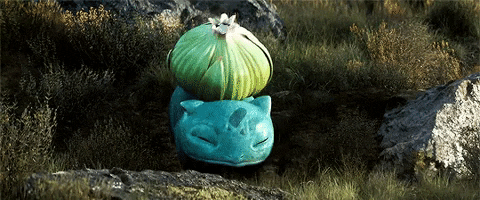
So imma get real nerdy real fast here. I love me some speculative extrapolation.
First off let's look at one of the official game designs real quick.

Okay, so, a sauroid design--I know that seems obvious from the name but hold on here, I have a point.
So here we have a large quadrapedal exotherm with obvious green coloration. Not just dull green, bright green. Given the species line is famous for learning Solar Beam, an attack that necessitates gathering sunlight and transforming it into an attack, we can probably be safe in assuming a lot of that green is chlorophyll, making this a rare non-marine vertebrate capable of using chlorophyll to produce energy for itself. And, occasionally, to gather enough energy to tell predators to step off.
The bulb and the... well, the 'saur, appear to be a package deal, but the bulb is not only distinct from the main body, it may be the primary source of its Grass typing, with the Poison typing belonging to the sauroid hefting that bulb around. That kinda distinction leads me to believe the bulb doesn't naturally grow on the Bulbasaur, and may be the result of a parent or sufficiently trained human implanting the seed for the bulb in its back. Meaning the body can have a set of two genetic parents while the bulb can have genetics coming from any flowering plants of that species in whatever area they're born to.
I wonder if the sauroids without bulbs are capable of surviving on their own or if this was an adaptation out of necessity. Like how megafauna in our actual world died off when the ecosystem could no longer support their energy needs. Are the bulbs needed to get to their size, leaving unaided young smaller to survive without the energy boost? If they were smaller and had weaker skin without the Grass-type boosting, I can see them being analogous to venomous toads. If they're needed for survival, it implies strong social ties, possibly entire colonies or troops of their evolutionary line, in order to provide new 'Saurs with their bulb seeds.
Also, if the two parts of the Bulbasaur are distinct, that implies the bulb is supplementing a diet that was already supporting the animal body. Given the name of the final evolution is Venusaur, I'm going to assume insects, probably birds and rodents once it grows larger and slower.
I'm almost entirely sure this thing lives in and around rainforests and jungles. Lots of moisture and sunlight for the chlorophyll and lots of biodiversity (to feast upon). It also fits with the assumed venomous amphibian origin.
I'm going to assume one of the oversimplifications is the evolution system, and that means the Bulbasaur, as pictured above, is a recognized and therefore official species for use in pokémon sport. There's probably all manner of variants not officially recognized, like ones that don't have their bulb, or who had their bulb seed malform somewhere along the line, or shift position in a way that hinders mobility. It also indicates a Bulbasaur that's battle ready can also lay or sire eggs, though without a ready support system, they're reliant on human aid to properly raise their young with bulbs. Based on body plan and energy requirements, I'm guessing covered nest with between one and three eggs, warm, kept damp, so the heat equally incubated the eggs. When they hatch, the young are kept hydrated and tucked away while a seed is implanted in their soft backs. Eventually, they are exposed more and more to the sunlight and the energy from that and catches brought to the nest helps them grow quickly until the adorable little starter beasts we so love.
There's more. There so much more. But I'll cover that next post or I'll ramble over the word limit.
15 notes
·
View notes
Text
Earth Day 2024
April 21, 2024, update: . . . " the average global temperature on Earth has increased by at least 1.2° Celsius (1.9° Fahrenheit) since 1880 (it increased 0.4° Celsius since 2016). There is only 0.3° Celsius of increase left before we hit the first tier of cataclysmic thresholds, according to environmental scientists.
According to an ongoing temperature analysis led by scientists at NASA’s Goddard Institute for Space Studies (GISS), "the average global temperature on Earth has increased by at least 1.2° Celsius (1.9° Fahrenheit) since 1880 (it increased 0.4° Celsius since 2016). The majority of the warming has occurred since 1975, at a rate of roughly 0.15 to 0.20°C per decade. . . . . The data reflect how much warmer or cooler each region was compared to the base period of 1951-1980. (The global mean surface air temperature for that period was 14°C (57°F), with an uncertainty of several tenths of a degree.)"
Adding to this is the growing number of methane sinkholes, each releasing several gigatons of gas per day. This growing phenomenon is changing all the current climate projections. Indeed, we might already have reached the climate tipping point.
There was a time when we believed that we were the center of the universe and that we should have dominion over the Earth. But then Copernicus came along, who asserted that the Sun is indeed the center of our solar system, the Moon being the only body that revolved around the Earth. I'm sure you know that this resulted in a bit of an uproar. As for the dominion idea, our use of resources, overhunting, and factory farming of animals has contributed to climate change and the current sixth extinction. Watch Marvin Gaye's video, Mercy, Mercy Me (The Ecology), released in 1971.
The following two photos show a contrast between Greenland's Tunu Glacier in 1933 and 2013. This melt-back is characteristic of ice all around the world, though melt-back varies widely, depending on location.
Source:
The Greenland Ice Sheet - 80 years of climate change seen from the air.
/ Bjørk, Anders Anker; Kjær, Kurt H.; Larsen, Nicolaj Krog; Kjeldsen, Kristian Kjellerup; Khan, Shfaqat Abbas; Funder, Svend Visby; Korsgaard, Niels Jákup. 2014. Abstract from 44th International Arctic Workshop, Boulder, Colorado, United States.
It wasn't so long ago that Carl Sagan and climate scientists started sounding the alarm that we were going down a dangerous path. Subsequent climate data has revealed that those early projections vastly underestimated what was happening, since we now know that climate change is not a linear but an exponential process. That is, it happens faster and faster over time.
Via Voyager 1 (click to enlarge)
The now famous photograph of Earth as a pale blue dot was taken on February 14, 1990 by the deep space probe, Voyager 1, from a record distance of about 6 billion kilometers (3.7 billion miles). The more recent
Via Cassini
photograph was taken by the deep space probe, Cassini. Though more striking with Saturn in the foreground, it also shows how Earth is but a spec in the cosmos. As Sagan said in his book: Look again at that dot. That's here. That's home. That's us. On it everyone you love, everyone you know, everyone you ever heard of, every human being who ever was, lived out their lives. (Carl Sagan, The Pale Blue Dot, 1994)
People often say we have to save the Earth. Not so! The Earth will go on just fine without us. The issue is preserving the current biosphere that supports us and the other higher vertebrates. There will always be life on the planet so long as there's liquid water. As I present every year, here is my fictionalized account of our worst scenario. Let's do better!
6 notes
·
View notes